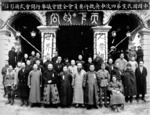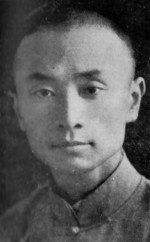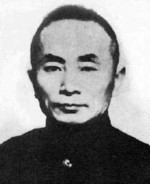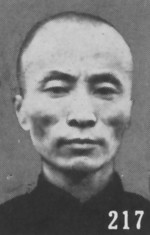Chen Guofu
| Surname | Chen |
| Given Name | Guofu |
| Born | 27 Oct 1892 |
| Died | 25 Aug 1951 |
| Country | China |
| Category | Government |
| Gender | Male |
Contributor: C. Peter Chen
ww2dbaseChen Zudao, known by his courtesy name Chen Guofu (Wade-Giles romanization: Chen Kuo-fu) in adulthood, was born to father Chen Qiye (courtesy name Qinshi) in Zhejiang Province, Qing Dynasty China in 1892. He studied in a military academy in his home province. His uncle Chen Yinshi (courtesy name Qimei) was a revolutionary, and had influenced his thinking, leading to him to join the Tongmenghui. He participated in the 1911 revolution that established the Republic of China and the campaign against Yuan Shikai's attempt to establish a monarchy. In 1920, he operated a stock brokerage firm, and had donated some of his profits to the Nationalist Party. In 1924 when Chiang Kaishek established the Whampoa Military Academy in Guangdong Province, from Shanghai, he recruited veterans and purchased materials for the academy. In 1926, he arrived in Guangzhou, Guangdong Province, and was elected a committee member of the Central Supervisory Committee of the Nationalist Party. In early Apr 1927, he established himself as a stern opponent of Communism. In the late 1920s and early 1930s, he held various party positions including the director of the Organizational Department and deputy head of the Control Yuan, progressively gaining influence in the party. A life long supporter of traditional Chinese medicine, he established the Central Traditional Medicine Institute in Nanjing, China in 1931 and served as its chairman. He contracted tuberculosis in the 1930s, but was able to keep the disease under control for the next two decades. In Oct 1933, he was made the governor of Jiangsu Province; in this role, he was best known for starting the major project of re-routing the Huai River to improve irrigation and to control flooding, though the project was eventually halted due to the start of WW2 in 1937. He stepped down as the Jiangsu governor in Nov 1937. With he and his administration's impressive record working with the Huai River, when the Nationalist central government faced a rapidly advancing Japanese Army, he suggested the opening of the Yellow River dikes near Zhengzhou in Henan Province. The Huayuankou dike was subsequently destroyed between 5 and 7 Jun 1938, resulting in the flooding of thousands of square kilometers of land. It destroyed thousands of villages and forced several million civilians to relocate. War time and post-war politics made the effect difficult, but most agree that it did not achieve the effect of deterring the Japanese advance, although the poor conditions made by the flooding prevented the Japanese from consolidating their control over the region. A Nationalist Party post-war commission estimated about 800,000 civilians were killed due to the effects of the flooding, and later scholarly investigations lowered the estimate to be between 400,000 to 500,000 dead. Communist figures tended to be higher, for propaganda purposes; for example, an official history published by the Communist Party in 1994 put the death figure at an impossibly high number of over 10,000,000 civilians, claiming that most of these numbers were war refugees, which was conveniently impossible to track. During the 1940s, Chen received several surgeries to mend his diseased lungs, thus contributed little to the war effort. He retired from politics in 1945 and moved to Taichung, Taiwan Province, China in Dec 1948. He passed away in Taipei, Taiwan in 1951 and was initially buried at the Wugu Cemetery in Wugu Township (now Wugu District, New Taipei City) in northern Taiwan. In 1999, his remains were re-interned in his home town at the Ling'an Cemetery in Daochang Village, Wuxing District, Huzhou, Zhejiang.
ww2dbaseHis brother, Chen Lifu, was also a an influential figure in the Nationalist Party. The two brothers together formed the backbone of the Central Club Clique of the party.
ww2dbaseSource: Wikipedia
Last Major Revision: Nov 2021
Photographs
 |  |  |  |
Chen Guofu Timeline
| 27 Oct 1892 | Chen Zudao was born in Wuxing County, Zhejiang Province, Qing Dynasty China. |
| 9 May 1937 | Chen Guofu inspected the Huai River rerouting project in Jiangsu Province, China. |
| 5 Jun 1938 | Suggested by Chen Guofu, Nationalist Chinese troops began digging tunnels under dike at Huayuankou, Henan Province, China. |
| 7 Jun 1938 | The dike at Huayuankou, Henan Province, China was destroyed by tunneling by Nationalist Chinese troops. Flood waters from the Yellow River quickly flooded about 54,000 square kilometers of land. Thousands of Japanese troops and at least 400,000 Chinese civilians were killed. |
| 25 Aug 1951 | Chen Guofu passed away in Taipei, Taiwan, Republic of China. |
Please consider supporting us on Patreon. Even $1 per month will go a long way! Thank you. Please help us spread the word: Stay updated with WW2DB: |

» Henan Campaign
- » 1,182 biographies
- » 337 events
- » 45,119 timeline entries
- » 1,248 ships
- » 350 aircraft models
- » 207 vehicle models
- » 376 weapon models
- » 123 historical documents
- » 261 facilities
- » 470 book reviews
- » 28,410 photos
- » 365 maps
Joachim von Ribbentrop, German Foreign Minister, Aug 1939
Please consider supporting us on Patreon. Even $1 a month will go a long way. Thank you!
Or, please support us by purchasing some WW2DB merchandise at TeeSpring, Thank you!